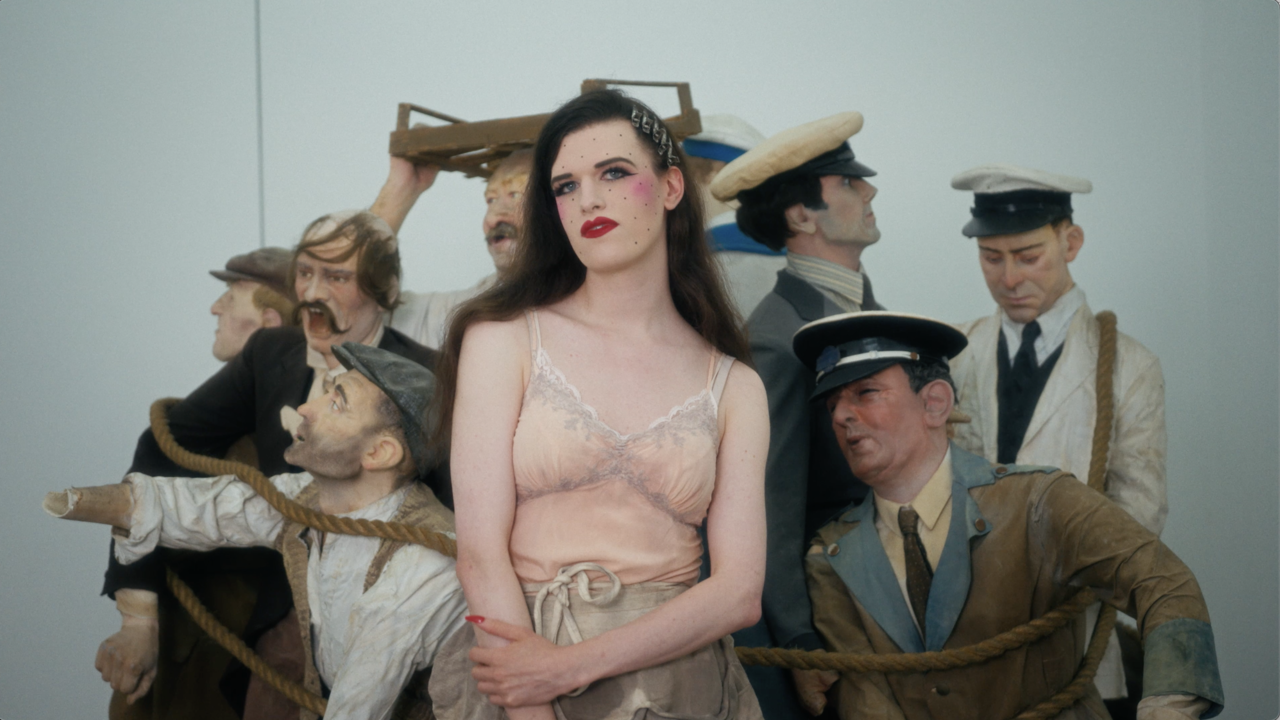Sung Hwan Kim
Cultural and subjective mobility; biography, fantasy, myth and rumour
Cultural and subjective mobility; biography, fantasy, myth and rumour

‘I know that it doesn’t matter if things are true or not, but this is a true story’, says Sung Hwan Kim at the start of his video From the Commanding Heights (2007). Leaning over a transparent screen placed above the camera lens, he tells the tale of a woman he knew who had a third ear on top of her head. When it rained, she had to plug it with a finger. (Kim demonstrates by drawing on the screen in green pen.) She was also blessed with a long and beautiful neck, which a family of snakes once mistook for a cave. She attempted to remove them by biting their heads off, but their scaly bodies remained, packed in her throat like sardines in a tin.
For Kim, it is obvious that truth and reality are not mutually dependent concepts. The film shifts abruptly to his description of the block of flats he lived in as a child in Seoul (he shows footage). There was a rumour, he says, that the frequent power cuts were instigated by President Park Chung-hee, who entered the block under cover of darkness to conduct an affair with a famous actress who lived there. One day Kim’s mother was visited by men in dark glasses who firmly told her that nothing had happened and she had seen no one. Regardless of the actual truth, the story itself, both in its original form and in his retelling, has become a fact.

When, in another change of tack, Kim introduces us to Amsterdam, where he studied, and describes the things he likes to do there (go to a cake shop, see animals in the zoo), it does not seem to matter that the person we see on screen performing these actions is not Kim, who is Asian, but a scruffy Caucasian. The man is, in fact, David DiGregorio, an American musician also known as dogr who features in many of Kim’s performances and videos, often standing in for the artist himself. In 2006’s Dog Video DiGregorio plays the role of Kim’s childhood dog, seemingly a coded surrogate for the artist, while Kim plays his own authoritarian father. There is much affection in the way Kim’s camera follows dogr, which is reflected in the singer’s tender, wistful lyrics and conspiratorial smiles at the camera. Their relationship, however, remains ambiguous, which is appropriate here; in Kim’s stories and dogr’s songs, the identities of ‘I’ and ‘you’ are always mobile, their narratives moving freely between the confessional and the imagined, the general and the specific. Perhaps this goes some way to defining what a performance is.
Part of this ambiguity arises through repetition. In the press release for his recent exhibition at Wilkinson Gallery, London, Kim writes: ‘I knew that male humpback whales of one population in a breeding season sing the same song, but each time this song is sung, it varies through imitation and improvisation.’ The exhibition included videos, drawings and installations from the series ‘In the Room’ (2006–ongoing), a sprawling and regenerative body of work that includes video, drawing, costume, installation, music and documentation of performances, installed in a darkened gallery – some pieces almost seemed to disappear into its gloomy recesses. In one video, which I later discovered derived from a 2007 performance, Pushing Against the Air, at De Appel, Amsterdam, Kim interrogates DiGregorio and another musician, Byungjun Kwon, about the inspiration for love songs they have written. While they appear to answer candidly, another video of Kim telling unsettling, fantastical stories while illustrating them on back-lit tissue paper, also originally part of Pushing Against the Air, reveals that this performance has been repeated many times with very slight variations.

South Korea, where Kim was born, has a cultural identity that depends on keeping many different narratives simultaneously in play. Embracing a Western model of capitalism has enabled huge economic expansion since the country was released from Japanese rule in 1945, despite a succession of authoritarian governments. The country is currently enjoying a period of cultural influence known as the ‘Korean Wave’ which owes as much to its export of television melodramas, which mix Western glamour with traditional Confucian themes, as it does to the country’s production of electronic and other consumer goods. Once again, fiction proves to be a force no less solid than materiality. In Kim’s film Summer Days in Keijo (2007), first shown at the 5th Berlin Biennial, we follow a female protagonist through the streets of Seoul (or Keijo as it was known until 1945). The work is based on two chapters of a book written in 1937 by the Swedish zoologist and ethnographer Sten Bergman, titled In Korean Wilds and Villages, in which the author complains that the old city is being swallowed by the new. ‘I don’t see my face in yours’, sings dogr at one point; Kim’s attempts to correlate what he sees with his expectations are as frustrated as Bergman’s.
Kim’s most recent film was shot in New York, where he now lives. Manahatas Dance (2009) takes its title from the 16th-century name for the land around the Hudson River. Amongst other wonders, it combines partly sung, partly chanted prophecies enacted by young people (‘when 33, a small leg grows on the knee’) with footage of Hispanic labourers moving shards of translucent plastic in front of their faces, and an excerpt from Barack Obama’s inauguration speech in which he promised to ‘harness the sun, and the winds and the soil, to fuel our cars and run our factories’. If Kim’s work often attempts to reconnect stories, contexts and media, then Manahatas Dance weaves together timescales both national, personal and cosmic into a thick plait, that shares with rumour, myth or fantasy both an unfettered strangeness and firm roots in reality.

























